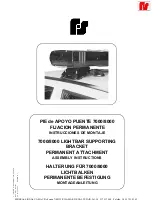
Coolant Level
The coolant bottle provides a quick
visual method for determining that
the coolant level is adequate. With the
engine cold, the level of the engine
coolant (antifreeze) in the coolant re-
covery bottle should be between the
ranges indicated on the bottle.
The radiator normally remains com-
pletely full, so there is no need to
remove the radiator cap unless check-
ing for engine coolant (antifreeze)
freeze point or replacing the engine
coolant (antifreeze). Advise your ser-
vice attendant of this. As long as the
engine operating temperature is satis-
factory, the coolant bottle only needs
to be checked once a month.
When additional engine coolant (an-
tifreeze) is needed to maintain the
proper level, it should be added to the
coolant bottle. Do not overfill.
Points To Remember
NOTE: When
the
vehicle
is
stopped after a few kilometers of
operation, you may observe vapor
coming from the front of the engine
compartment. This is normally a
result of moisture from rain, snow,
or high humidity accumulating on
the radiator and being vaporized
when the thermostat opens, allow-
ing hot engine coolant (antifreeze)
to enter the radiator.
If an examination of your engine com-
partment shows no evidence of radia-
tor or hose leaks, the vehicle may be
safely driven. The vapor will soon dis-
sipate.
• Do not overfill the coolant recovery
bottle.
• Check the engine coolant (anti-
freeze) freeze point in the radiator
and in the coolant recovery bottle.
If engine coolant (antifreeze) needs
to be added, contents of the coolant
recovery bottle must also be pro-
tected against freezing.
• If frequent engine coolant (anti-
freeze) additions are required, or if
the level in the coolant recovery
bottle does not drop when the en-
gine cools, the cooling system
should be pressure tested for leaks.
• Maintain engine coolant (anti-
freeze) concentration at 50% en-
gine coolant (antifreeze) (mini-
mum) and distilled water for
proper corrosion protection of your
engine, which contains aluminum
components.
• Make sure that the radiator and
coolant recovery bottle overflow
hoses are not kinked or obstructed.
• Keep the front of the radiator clean.
If your vehicle is equipped with air
conditioning, also keep the front of
the condenser clean.
• Do not change the thermostat for
Summer or Winter operation. If re-
placement is ever necessary, install
ONLY the correct type thermostat.
Other designs may result in unsat-
isfactory
coolant
performance,
poor gas mileage, and increased
emissions.
312
Содержание Voyager 2013
Страница 1: ...Owner Handbook...
Страница 3: ......
Страница 6: ......
Страница 8: ...2...
Страница 13: ...7...
Страница 74: ...68...
Страница 105: ...99...
Страница 106: ...100...
Страница 107: ...101...
Страница 166: ...160...
Страница 172: ...INSTRUMENT CLUSTER GASOLINE 166...
Страница 173: ...INSTRUMENT CLUSTER DIESEL 167...
Страница 266: ...260...
Страница 286: ...280...
Страница 337: ...331...
Страница 338: ...332...
Страница 347: ...9 INDEX 341...
Страница 357: ...Notes...
Страница 359: ......
















































